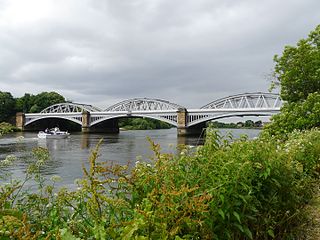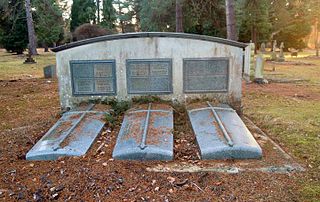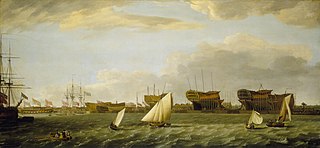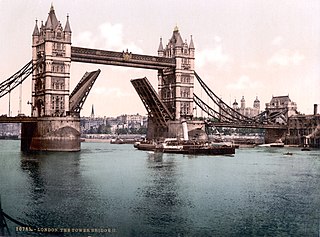Related Research Articles

The Indus is a transboundary river of Asia and a trans-Himalayan river of South and Central Asia. The 3,120 km (1,940 mi) river rises in mountain springs northeast of Mount Kailash in Western Tibet, flows northwest through the disputed region of Kashmir, bends sharply to the left after the Nanga Parbat massif, and flows south-by-southwest through Pakistan, before emptying into the Arabian Sea near the port city of Karachi.

The Hungerford Bridge crosses the River Thames in London, and lies between Waterloo Bridge and Westminster Bridge. Owned by Network Rail Infrastructure Ltd it is a steel truss railway bridge flanked by two more recent, cable-stayed, pedestrian bridges that share the railway bridge's foundation piers, and which are named the Golden Jubilee Bridges.

Cubitt Town is a district on the eastern side of the Isle of Dogs in London, England. This part of the former Metropolitan Borough of Poplar was redeveloped as part of the Port of London in the 1840s and 1850s by William Cubitt, Lord Mayor of London (1860–1862), after whom it is named. It is on the east of the Isle, facing the Royal Borough of Greenwich across the River Thames. To the west is Millwall, to the east and south is Greenwich, to the northwest Canary Wharf, and to the north — across the Blue Bridge — is Blackwall. The district is situated within the Blackwall & Cubitt Town Ward of Tower Hamlets London Borough Council.

Chelsea Bridge is a bridge over the River Thames in west London, connecting Chelsea on the north bank to Battersea on the south bank, and split between the City of Westminster, the London Borough of Wandsworth and the Royal Borough of Kensington and Chelsea. There have been two Chelsea Bridges, on the site of what was an ancient ford.

Sukkur is a city in the Pakistani province of Sindh along the western bank of the Indus River, directly across from the historic city of Rohri. Sukkur is the third largest city in Sindh after Karachi and Hyderabad, and 14th largest city of Pakistan by population. The city was originally founded by the Rai dynasty of Sindh. The modern city was built in the 1840s. New Sukkur was established during the British era alongside the village of Sukkur. Sukkur's hill, along with the hill on the river island of Bukkur, form what is sometimes considered the "Gate of Sindh".

The Thames Ironworks and Shipbuilding Company, Limited was a shipyard and iron works straddling the mouth of Bow Creek at its confluence with the River Thames, at Leamouth Wharf on the west side and at Canning Town on the east side. Its main activity was shipbuilding, but it also diversified into civil engineering, marine engines, cranes, electrical engineering and motor cars.

Attock, formerly known as Campbellpur, is a city in Punjab, Pakistan, not far from the country's capital Islamabad. It is the headquarters of the Attock District and is 36th largest city in the Punjab and 61st largest city in the country, by population. The city was founded in 1908 several miles southeast of the historical city of Attock Khurd, which had been established by the Mughal Emperor Akbar in the 16th century, and was initially named in honour of Sir Colin Campbell.

Barnes Railway Bridge is a Grade II listed railway bridge in the London Borough of Richmond upon Thames and the London Borough of Hounslow. It crosses the River Thames in London in a northwest to southeast direction at Barnes. It carries the South Western Railway's Hounslow Loop Line, and lies between Barnes Bridge and Chiswick stations. It can also be crossed on foot, and is one of only three bridges in London to combine pedestrian and rail use; the others being Hungerford Bridge and Golden Jubilee Bridges and Fulham Railway Bridge.

Sukkur Barrage is a barrage on the River Indus near the city of Sukkur in the Sindh province of Pakistan. The barrage was built during the British Raj from 1923 to 1932 and was named Lloyd Barrage. The Sukkur Barrage, is the pride of Pakistan's irrigation system as it is the largest single irrigation network of its kind in the world. It irrigates from Sukkur district in the north, to Mirpurkhas/Tharparkar and Hyderabad districts in the south of Sindh, almost all parts of the province. It is situated about 500 kilometres northeast of Karachi, 5 kilometres below the railway bridge, or the Sukkur Gorge. The introduction of barrage-controlled irrigation system resulted in more timely water supplies for the existing cultivated areas of Sindh province of Pakistan.

Sir Alexander Meadows Rendel, was an English civil engineer.

The Lansdowne Bridge over the Indus at Sukkur was one of the great engineering feats of the 19th century. The longest cantilever bridge ever built, it had to support the load of heavy steam locomotives. The bridge was inaugurated on March 25, 1889. The Ayub Bridge was built immediately adjacent to the bridge in 1962, to separate the road and Railway traffic. Hence the photographs of the Landsdown Bridge usually also show the Ayub Bridge.
Rail transport in Pakistan began in 1855 during the British Raj, when several railway companies began laying track and operating in present-day Pakistan. The country's rail system has been nationalised as Pakistan Railways. The system was originally a patchwork of local rail lines operated by small private companies, including the Scinde, Punjab and Delhi Railways and the Indus Steam Flotilla. In 1870, the four companies were amalgamated as the Scinde, Punjab & Delhi Railway. Several other rail lines were built shortly thereafter, including the Sind–Sagar and Trans–Baluchistan Railways and the Sind–Pishin, Indus Valley, Punjab Northern and Kandahar State Railways. These six companies and the Scinde, Punjab & Delhi Railway merged to form the North Western State Railway in 1880. Following the independence of Pakistan in 1947, the North Western Railway became Pakistan Western Railway and the rail system was reorganised in the dominion of Pakistan; some of the reorganisation was controversial. Rail use increased in early 1948, and the network became profitable. Declining passenger numbers and financial losses in the late 1980s and early 1990s prompted the closure of many branch lines and small stations. The 1990s saw corporate mismanagement and severe cuts in rail subsidies. Due to falling passenger numbers, government subsidies are necessary to keep the railways financially viable.

Blackwall Yard is a small body of water that used to be a shipyard on the River Thames in Blackwall, engaged in ship building and later ship repairs for over 350 years. The yard closed in 1987.

Steamboat services started on the Thames in around 1815 and for nearly 25 years were the main use of steam to carry passengers before the emergence of railways in the south of England. During this time at least 80 steamers are recorded in the Thames and the Steamboat Act of 1819 became the first statute to regulate the safety of the new technology for the public. Wooden boats driven by paddle-wheels, they managed during this time to establish themselves as faster and more reliable than the earlier use of sailing and rowing boats for passenger transport within the Thames estuary.
London Yard was a shipyard in London, in use between around 1856 and 1908 by various shipbuilding companies, including Westwood, Baillie and Yarrow Shipbuilders.

Ayub Bridge, named after Field Marshal Mohammad Ayub Khan, is a railway bridge over the Indus river between Rohri and Sukkur in Sindh province, Pakistan. The bridge is about 806 feet long, 247 feet high and cost Rs21.6 million. It has served the city for 50 years by providing a strong link for rail traffic between Sukkur and Rohri. Before this, Lansdowne Bridge was the railway link between Sukkur and Rohri. The foundation stone of this steel arch bridge was laid on 9 December 1960 and inaugurated by President Muhammad Ayub Khan on 6 May 1962. The consulting engineer was David B. Steinman. The Ayub Bridge became the world's third longest railway arch span and the first railway bridge in the world to be slung on coiled wire rope suspenders.

Karachi–Peshawar Railway Line is one of four main railway lines in Pakistan, operated and maintained by Pakistan Railways. The line starts from Kiamari station in the province of Sindh and ends at Peshawar Cantonment Station in Khyber Pakhtunkhwa province. The total length of the line is 1,687 kilometers (1,048 mi), with 173 railway stations from Kiamari to Peshawar Cantonment. The line serves as the main passenger and freight line of the country. 75% of the country's cargo and passenger traffic uses the line. The line will undergo a six-year 6.8 billion USD upgrade and renovation as part of the China Pakistan Economic Corridor, with the average speed expected to be doubled to 140 kilometers per hour upon completion. The railway track is dual between Keamari and Shahdara Bagh, Chaklala and Golra Sharif.
The Indus Valley State Railway was a railway founded in 1871 to provide a rail link between Kotri and Multan and to replace the Indus Steam Flotilla. The opening of the line thus connected Karachi with Lahore.
The Jervois Bridge is a bridge in Greater Adelaide, Australia that crosses the Port River.
References
- ↑ "Tower Hamlets Local History Library and Archives Miscellaneous Business Records". The National Archives. Retrieved 12 August 2011.
- ↑ "Cubitt Town: Riverside area: from Cubitt Town Pier to the Graving Docks". Survey of London: volumes 43 and 44: Poplar, Blackwall and Isle of Dogs. 1994. pp. 532–539. Retrieved 12 August 2011.
- ↑ "GLIAS rail tour". GLIAS news. Greater London Industrial Archaeology Society. December 1995. Retrieved 12 August 2011.
- ↑ "No. 26593". The London Gazette . 29 January 1895. p. 615.
- ↑ "Joseph Westwood and Co". Grace's Guide. Retrieved 12 August 2011.
- ↑ "Friends of Tower Hamlets Cemetery Park Gallery" . Retrieved 12 August 2011.
- 1 2 "Thames Tugs". Thames Tugs. Retrieved 12 August 2011.
- 1 2 "History of London Yard" . Retrieved 12 August 2011.
- ↑ Ballard, G. A., Admiral (1980). The Black Battlefleet. Annapolis, MD: Naval Institute Press. ISBN 0-87021-924-3.
{{cite book}}: CS1 maint: multiple names: authors list (link) - ↑ "Ships launched 1863-64". Illustrated London News.
- ↑ "William Watkins Limited Fleet List". Thames Tugs. Retrieved 12 August 2011.
- ↑ "A history of tugs on the River Tyne" . Retrieved 12 August 2011.
- ↑ "Jervois Swing Bridge" . Retrieved 12 August 2011.
- ↑ "INDIA—THE ATTOCK BRIDGE". Parliamentary Debates (Hansard) . 21 June 1880. Retrieved 12 August 2011.
- ↑ "Westwood Baillie Co". Structurae. Retrieved 12 August 2011.
- ↑ "Lansdowne Bridge, Sukkur" . Retrieved 12 August 2011.
- ↑ "London Lighterage Tugs".